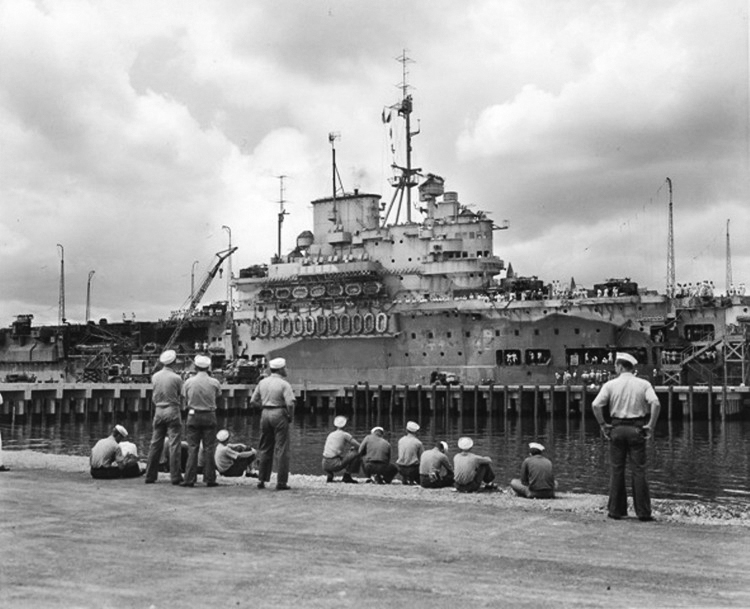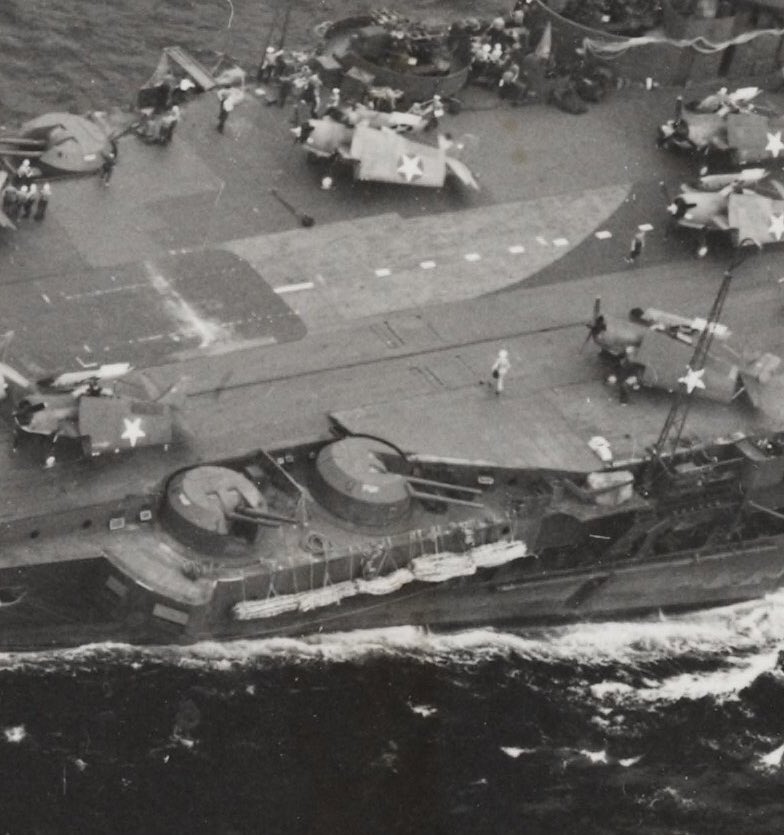South Pacific:
USS Robin (Part One)
by Mike Bennighof, Ph.D.
November 2024
 In the October 1942 Battle of the Santa Cruz Islands, the Pacific War’s fourth clash of carriers, the Japanese finally scored a clear victory. Japanese planes sank the American carrier Hornet and crippled her consort Enterprise, while Saratoga had been torpedoed in September and sent away for repairs. That left the U.S. Navy with no aircraft carriers to cover the ongoing campaign on Guadalcanal. In the October 1942 Battle of the Santa Cruz Islands, the Pacific War’s fourth clash of carriers, the Japanese finally scored a clear victory. Japanese planes sank the American carrier Hornet and crippled her consort Enterprise, while Saratoga had been torpedoed in September and sent away for repairs. That left the U.S. Navy with no aircraft carriers to cover the ongoing campaign on Guadalcanal.
Vice Admiral William Halsey, the American commander at Santa Cruz, asked his boss Chester Nimitz to request an aircraft carrier from the British Eastern Fleet be loaned to the Americans in the South Pacific. Nimitz passed the request up the line, and after languishing for a couple of weeks in the American naval bureaucracy it reached the Admiralty, who promptly agreed.
The Eastern Fleet had only one carrier at the time, Illustrious, then providing air cover for the Allied invasion of Madagascar. First Sea Lord Sir Dudley Pound offered to send Illustrious and her sister Victorious from the British Home Fleet, in exchange for the American carrier Ranger serving with Home Fleet. Ranger was less capable than the two British carriers and considered too vulnerable to operate against the Japanese, but perfectly adequate to provide fighter cover and ASW support on the Murmansk Run. The Americans demurred, citing a need for a training carrier at home.

Victorious shortly after arrival at Pearl Harbor (she retains her Royal Navy disruptive paint scheme in this photo).
However, the carriers could not be detached until after Operation Torch, the invasion of French North Africa scheduled for November 1942, had been completed. And then only if no pressing need for them arose in the aftermath. Sir Dudley wrote that he preferred to send both carriers, allowing them to work together as a tactical unit, thereby combining their air groups (much smaller than those of American flattops) to together approach the strength of an American fleet carrier.
After months of hard service, both British carriers suffered serious defects. Immediately after Sir Dudley’s offer, Illustrious proceeded to Durban, South Africa for refitting, where she spent all of October and November before returning to Britain where she spent the next four months undergoing overhaul, including an extension of the flight deck and installation of modern new aircraft warning, surface warning and fire control radars. She did not return to active duty until July 1943.
Victorious spent September and October 1942 under refit in Britain, receiving a new Aircraft Direction Center. After some anti-submarine patrols off Gibraltar in support of Operation Torch, she set out for Norfolk, Virginia on 20 December. Along with an escorting cruiser and three destroyers, she fought her way through a Force 9 gale to arrive on 31 December 1942 after a stop at Bermuda.

Victorious crewmen sample local entertainment.
At American insistence, the ship underwent significant changes for Pacific service. She immediately entered drydock upon her arrival in the United States, remaining there until 31 January 1943. Dockyard workers performed an extensive and apparently badly-needed overhaul, and made a number of changes to the ship. Her flight deck was extended by ten feet at the aft end to accommodate an additional arrestor wire, necessary for the larger and more powerful aircraft she would now operate. Workers installed new American search radars (air and surface), communications gear, homing systems and cypher equipment. She received additional 20mm anti-aircraft guns, expanded mess space and fire-suppression systems in her crew areas.
After a great deal of discussion and bureaucratic wrangling, the Admiralty and the U.S. Navy agreed that Victorious would retain her British air crews, but they would operate American aircraft using American procedures. New arrestor wires were fitted to the flight deck to handle the heavier American planes, and the British deck crew learned American take-off and landing procedures. All of the British crew received American-issued dungarees (for the enlisted men) and khakis (for the officers) to wear while operating in the Pacific. Photo evidence shows that the crew kept their British issue until they actually reached the Solomons.
New Grumman F4F-4 Wildcats and TBM Avengers replaced the Martlets, Fulmars and Albacores that had arrived at Norfolk with Victorious. Some of these planes had been issued to Victorious just before departing Britain, to give her a complete and up-to-date air group; now they would be shipped back across the Atlantic. Since Victorious would operate under American command, the Americans had undertaken to outfit her with aircraft from their own stocks.

Victorious and her air group at Noumea, New Caledonia. The Fleet Air Arm squadrons carried U.S. Navy markings for this deployment (Victorious deck hands added a small, unauthorized “Royal Navy” stencil).
The F4F-4 was identical to the Martlet IV, and the fighter pilots needed no transition training. The big Avenger was a different story; the ship’s aircraft cranes could not lift the planes when fully loaded, and the Avengers would only just barely fit on the ship’s aircraft elevators. The American liaison team suggested that Victorious fly only fighters, but Capt. L.D. Mackintosh demurred, not wishing to leave his ship without the anti-submarine capabilities of the Avenger. The Americans did not press the issue, and at least at first Victorious would operate both fighters and torpedo bombers.
A small group of British pilots had already arrived in the United States for training with the Avenger. While the Navy Yard worked on their carrier, the rest of the torpedo pilots familiarized themselves with their new plane. It was much less forgiving than their Albacore biplanes, and its weight and power caused it to strain the British ship’s arrestor wires even after replacement; they would be re-fitted again at Pearl Harbor after four separate incidents of an Avenger hitting the crash barrier despite fully engaging its tailhook.

A close-up of Victorious and her American-made aircraft.
British practice restricted an air group to only those aircraft that could be struck below into the hangar. Now under American command, Victorious added a deck park, increasing her capacity to from 42 planes (24 Martlets and 18 Albacores) to 52 (36 Martlets and 16 Avengers) but requiring that the deck crews learn complicated new procedures to move parked aircraft to allow take-offs and landings.
Together with the American destroyers Pringle, Bache and Converse, Victorious set out from Norfolk on 3 February, conducting flight exercises as she steamed southward. Her official call sign, “Robin,” became the unofficial name applied to her by American and eventually British sailors while she served the U.S. Navy. The Avengers proved just as troublesome in flight as on deck, with two fatal accidents claiming British aircrew.
Victorious barely fit through the Panama Canal, even after her crew removed some of her sponsons and aerials. She exchanged scrapes and gashes with the Gatun Locks, prompting the canal management to present a bill for damages before she entered the Pacific. Mackintosh scrawled “Lease Lend” across it and handed it back.
Click here to join the Gold Club.
See your Gold Club Insider newsletter for ordering information.
Sign up for our newsletter right here. Your info will never be sold or transferred; we'll just use it to update you on new games and new offers.
Mike Bennighof is president of Avalanche Press and holds a doctorate in history from Emory University. A Fulbright Scholar and NASA Journalist in Space finalist, he has published a great many books, games and articles on historical subjects; people are saying that some of them are actually good.
He lives in Birmingham, Alabama with his wife, three children, and new puppy. He misses his lizard-hunting Iron Dog, Leopold.
Daily Content includes no AI-generated content or third-party ads. We work hard to keep it that way, and that’s a lot of work. You can help us keep things that way with your gift through this link right here.
|
